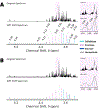Analysis of Small-Molecule Mixtures by Super-Resolved 1H NMR Spectroscopy
- PMID: 36413171
- PMCID: PMC10228708
- DOI: 10.1021/acs.jpca.2c06858
Analysis of Small-Molecule Mixtures by Super-Resolved 1H NMR Spectroscopy
Abstract
Analysis of small molecules is essential to metabolomics, natural products, drug discovery, food technology, and many other areas of interest. Current barriers preclude from identifying the constituent molecules in a mixture as overlapping clusters of NMR lines pose a major challenge in resolving signature frequencies for individual molecules. While homonuclear decoupling techniques produce much simplified pure shift spectra, they often affect sensitivity. Conversion of typical NMR spectra to pure shift spectra by signal processing without a priori knowledge about the coupling patterns is essential for accurate analysis. We developed a super-resolved wavelet packet transform based 1H NMR spectroscopy that can be used in high-throughput studies to reliably decouple individual constituents of small molecule mixtures. We demonstrate the efficacy of the method on the model mixtures of saccharides and amino acids in the presence of significant noise.
Conflict of interest statement
The authors declare no competing financial interest.
Figures




References
MeSH terms
Grants and funding
LinkOut - more resources
Full Text Sources

